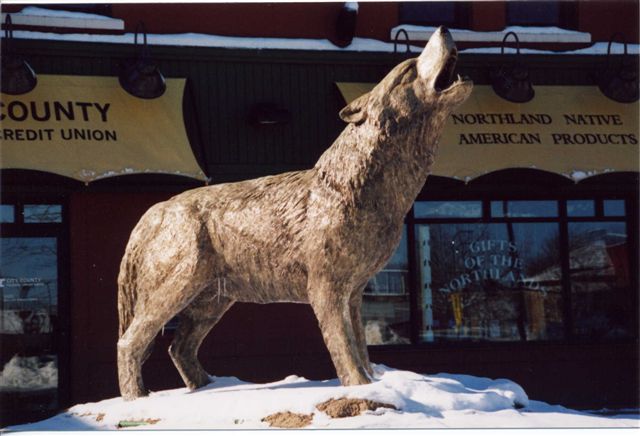Mohegan Arrives on Franklin
To lead off our upcoming focus on public art and architecture, here's Dean Seal with the story of a serendipitous arrival of a sculpture.

The statue Mohegan is cast in bronze with a zinc and silver finish. It is startling in its realness, hefty in size, moving in its immediacy and thrilling to walk up and touch. But it means a lot more to those who would keep it on its plinth at the Ancient Traders Market.
This is public art at its most connective, most tangible. It is the story of a community that needs symbols that help revivify a culture. The story is ongoing; as Faulkner said, “The past isn’t over. It isn’t even past.”
The Ancient Trader’s Market was started by the American Indian
Neighborhood Development Corporation (AINDC) to serve the needs of Franklin Avenue’s Native American community. Minneapolis has one of the nation’s largest urban American Indian Communities. The AIBDC was started by five American Indian women in 1975 with a mission to “empower American Indian People through all business development along Franklin Avenue.” They have fostered new construction, incubated new businesses, replaced faltering tenants with successful ones, and
lowered the crime rate. But there’s more.
They kept in mind the use of public art and the encouragement of private art sales in order to build up the ecology of the Native Artist community. Making a visible commitment to public art in the streets cape of the Avenue has added to the livability of the neighborhood, for residents and visitors. The Ancient Traders Art Gallery has had a number of successful shows of native artists who are working in both traditional and modern formats. They have been featured several times in the Star Tribune with rave reviews. For my own tastes, I have found work there that was spiritual, beautiful, riveting, sacred, profane, funny and amazing. Sometimes in the same show.
AINDC has been putting a lot of work into the neighborhood center where their offices are, above Maria’s Cafe (the best corn pancakes in town) and the parking lot had been built with numerous artistic touches. The sidewalks for the whole block had traditional Indian glyphs, there were iron sculptures with native motifs.But they wanted something bigger. A piece of public sculpture that would make a statement and be cool to look at. They had them install a plinth, a pedestal, to accommodate that piece when it came to pass.
There were only a few problems with the idea. First, public artists are rare, and Indian public artist sculptors would be very rare. Second, they had no money to buy a piece. We’ve heard that one before. But if you build it, Mohegan would come.
A staffer looked out the window one day and saw what she thought was a large stuffed wolf. She left her office to investigate, and discovered it was this piece of perfectly executed natural bronze of the wolf. The sculptor Lloyd Pinay (Plains Ojibwe/Cree) was in the truck hauling it, and maybe he had stopped for lunch at Maria’s before heading back to Saskatchewan. It was discovered that he needed a place to store the piece. A light bulb went off in someone’s head, the piece was set on the plinth, and the fundraising to pay the sculptor, through grants and gifts, is in progress.
The wolf is featured in much native mythology for its dedication to the pack. They each work for the pack in their own way individually, and share with the pack as a whole. If a wolf is injured and can no longer work, the other wolves bring it food so it doesn’t starve. Evidence, certainly, that wolves are not Republicans. Storytellers have long used the wolf as a role model of dedication to family and tribe. An Ojibwe elder is quoted: “Our people are like the wolf, we need community, we need to work together and we need to do our share.”
On its pedestal at the Ancient Traders Market Plaza, it just looks like a home run. Kids clamber around it, it can be seen from the sidewalk and street, you can walk right up to it. Last winter someone put a ball it its mouth. Fathers lift their two year olds up to pet it. The wolf is confident, at home, howling in triumph at its return from extinction.
The Ancient Traders Art Gallery featured a show this spring that Shirlee Stone curated; it marks a place in time where this sculpture lives. The show is of four painters, and it is called “Seventh Generation.” It recalls that this is the seventh generation since the white man (like me) broke the Sacred Hoop; and the spiritual leaders at the time looked ahead to the Seventh Generation that would restore traditional ways.
Pottery by Carrie Ortiz (White Earth Anishinabe), plus humorous and serious political work by Missy Whiteman (Arapaho and Kickapoo) evoke directly American Indian themes. Then the fabulous paintings by Patrick Rolo and Thomas Thein (both are Bad River Band of Ojibwe) show modern technique shaped with a luminous point of view that is breathtaking.
Personally, I have to confess: Patrick Rolo knocks me out.
And Mohegan stands outside announcing the arrival of this, the Seventh Generation. This is the Native Renaissance, busting open on Franklin Avenue, for anyone who wants to see it.
Mohegan is in the plaza of Ancient Trader’s Market, between 11th and 13th Avenues and Franklin and 21st. St. The plaza holds Maria’s, the Northland Native American Products store, a Minneapolis Police Substation, a Snyder’s Drug Store, and the City County Federal Credit Union. It is a favorite stopping point for tourists from Europe and visitors to the convention center.
For information on how to donate to the Mohegan acquisition fund, or to learn more about AIBDC and the Ancient Traders Gallery, call 612=870-7555. The Gallery is located at 1113 Franklin Ave. E. in Minneapolis.